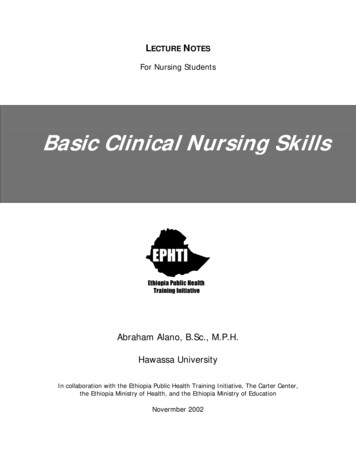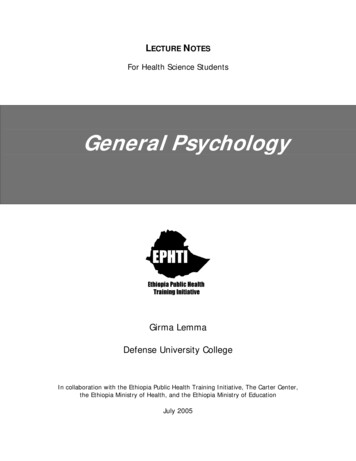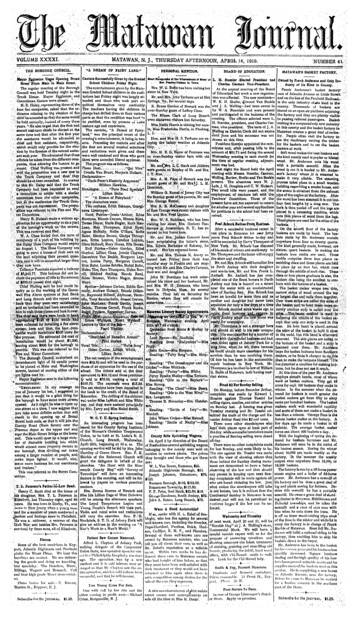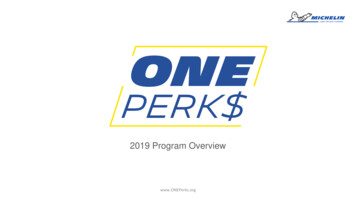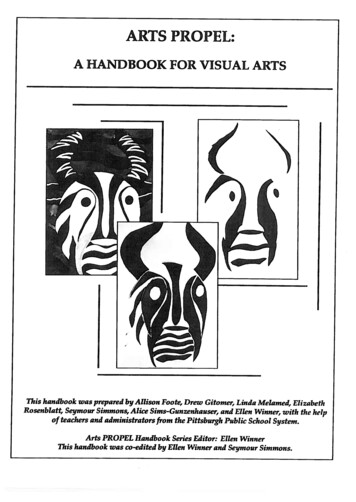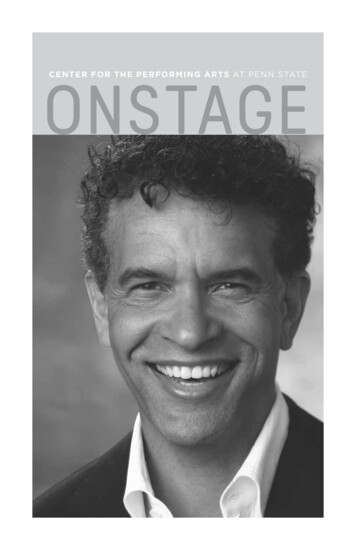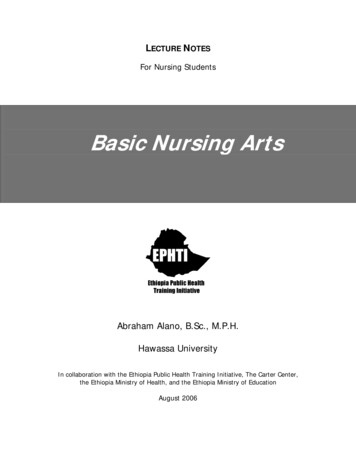
Transcription
LECTURE NOTESFor Nursing StudentsBasic Nursing ArtsAbraham Alano, B.Sc., M.P.H.Hawassa UniversityIn collaboration with the Ethiopia Public Health Training Initiative, The Carter Center,the Ethiopia Ministry of Health, and the Ethiopia Ministry of EducationAugust 2006
Funded under USAID Cooperative Agreement No. 663-A-00-00-0358-00.Produced in collaboration with the Ethiopia Public Health Training Initiative, The CarterCenter, the Ethiopia Ministry of Health, and the Ethiopia Ministry of Education.Important Guidelines for Printing and PhotocopyingLimited permission is granted free of charge to print or photocopy all pages of thispublication for educational, not-for-profit use by health care workers, students orfaculty. All copies must retain all author credits and copyright notices included in theoriginal document. Under no circumstances is it permissible to sell or distribute on acommercial basis, or to claim authorship of, copies of material reproduced from thispublication. 2006 by Abraham AlanoAll rights reserved. Except as expressly provided above, no part of this publication maybe reproduced or transmitted in any form or by any means, electronic or mechanical,including photocopying, recording, or by any information storage and retrieval system,without written permission of the author or authors.This material is intended for educational use only by practicing health care workers orstudents and faculty in a health care field.
PREFACENursing is core part in health service delivery system in which ilitativehealthstrategies are applied. The skill of basic nursing art for the beginningpublic heath nurse is of paramount important. The purpose of preparingthis lecture note is to equip public health nurses with basic nursing skills,which will enable them to dispatch their responsibility as well as todevelop uniformity among Ethiopian Public Health Nurse Training HigherInstitutions.The lecture note contains basic selected topics, which are relevant to theirscope. It is well known that no nursing service can be provided with outbasic skills of nursing art. For public health nurse to provide health serviceat different settings; hospital, health center, health post and at thecommunity level, the course is very essential.The lecture note is therefore organized in logical manner that studentscan learn from simpler to the complex. It is divided in to units and subtopics. Important abbreviations and glossaries have been included inorder to facilitate teaching learning processes. On top of that learningobjectives are clearly stated to indicate the required outcomes. Trial ismade to give some scientific explanation for procedure and some relevantstudy questions are prepared to each unit to aid students understand thesubject.
ACKNOWLEDGMENTSMy deepest appreciation is to Carter Center and Professor DennisCarlson, senior consultant of the Center for his undivided and genuinesupport starting from initiation of the lecture note preparation, provision ofmaterials and technical advise.I also extend many thanks to colleagues from sisterly institutions and staffof our department for their valuable comments and criticism, other wisethe lecture note would have not been shaped.Similarly, my felt thanks is to supportive staff of Carter Center, Ato AkliluMulugetta for his devoted support through the preparation of this lecturenote.Last but not least, I thank all our College authorities for permission to workon this lecture note besides the routine activities of the college.
ABBREVATIONS & SYMBOLSA.C.Before meal (ante cibum)ACTHAdreno cortico trophic hormoneAD.As desiredAM.MorningAMALGAmalgam fillingAMAAgainst medical adviceA and PAuscultation and percussionAPCAspirin, Phenacetine & caffeineAQAqueousBIDTwice a day (bis in die)B.MBowel movementB.M.R.Basal metabolic rateB.PBlood pressureB.R.P.Bathroom privilegeBUNBlood urea nitrogenoCentigradeC.B. CComplete blood countCCCubic centimeterC.N. S.Central nervous systemCo2Carbon dioxideC.S. F.Cerebro- spinal fluidD and CDilatation and CurettageD/NSDextrose in normal salineDPTDiphtheria, pertusis, tetanusD/WDextrose in waterDxDiagnosisEEGElectro encephalogramE.E.N.T.Eye, ear, nose, throatC
ECGElectrocardiogramoFahrenheitF.B.S.Fasting blood sugarF.H.B.Fetal heartbeatG.I.Gastro intestinalG or GmGramgr.Graingt.Drop (gutte)gtt.DropsG.U.Genito urinaryGYN.GynecologyHCLHydrochloric acidHbHemoglobinHSAt bed- time (hours of sleep)H2oWaterI.V.IntravenousI.V.PIntravenous pyelogramKI.Potassium iodideL. PLumbar punctureNaClSodium ChlorideNOCTEAt nightN.P.O.Nothing by mouth (nothing by os)O.P.D.Out Patient DepartmentO.R.Operating roomPMAfter noonPRNAs needed, when necessaryPt.PatientQ.EveryQ.D.Every DayF
Q.H.Every HourQ.I.D.Four times a dayQ.N.Every nightQ.O.D.Every other dayR.B.C.Red blood count or red blood cellRh.Rhesus factorRxPrescription, takeSol.SolutionSOSIf necessarySTATImmediately -at onceS.CSubcutaneousT. I.DThree times a dayT.P.R.Temperature, pulse, respirationTspTeaspoon, tablespoonU.R.Upper rightWBCWhite blood cellsWt.WeightU.R.Q.Upper right quadrantU.L.Q.Upper lower quadrantUTIUrinary tract Infection
1Basic Nursing iUnit OneIntroductiion1Unit TwoCare of the patient unit and equipment4Unit ThreeBed Making22Unit FourGeneral care of the patient29Unit FiveObservation and laboratory diagnosis57Unit SixCold and heat application89Unit SevenElimination of Gastro Intestinal And Urinary Tract92Unit EightMedication Administration111Unit NineWound care138Unit TenPre & postoperative nursing care151Unit ElevenPost- mortem care162Glossary165References169
1Basic Nursing ArtUNIT ONEINTRODUCTIONNursingDefinition:It is assisting the individual, sick or well in the performance of thoseactivities contributing to health or its recovery (to peaceful death) that hewill perform unaided, if he had the necessary strength, will or knowledgeand to do this in such a way as to help him gain independence as rapidlyas possible (Virginia Henderson 1960).Nursing is the art and science involves working with individual, families,and communities to promote wellness of body, mind, and spirit. It is adynamic, therapeutic and educational process that serves to meet thehealth needs of the society, including its most vulnerable members.Historical Background of NursingIn the early ages, much of the practice of medicine was integrated withreligious practices. Before the development of modern nursing, womenof nomadic tribes performed nursing duties, such as helping the veryyoung, the old, and the sick, care-dwelling mothers practiced the nursingof their time.As human needs expanded, nursing development broadened; its interestand functions through the social climates created by religious ideologies,economics, industrial revolutions, wars, crusades, and education. In thisway modern nursing was born.The intellectual revolution of the 18th and 19th centuries led to a scientificrevolution. The dynamic change in economic and political situations alsoinfluenced every corner of human development including nursing. It wasduring the time of Florence Nightingale that modern nursing developed.
Basic Nursing Art2She greatly modified the tradition of nursing that existedbefore her era. She also contributed to the definition of nursing " to putthe patient in best possible way for nature to act." Since her time modernnursing development has rapidly occurred in many parts of the world.History of Nursing in EthiopiaEven though Ethiopia is one of the oldest countries in the world,introduction of modern medicine was very late. Health care ofcommunities and families was by Hakim (wogesha or traditional healers).Around 1866 missionaries came to Eritrea, (one of the former provincesof Ethiopia) and started to provide medical care for very few members ofthe society. In 1908 Minlik II hospital was established in the capital ofEthiopia. The hospital was equipped and staffed by Russians.Later hospital building was continued which raised the need to trainhealth auxiliaries and nurses. In 1949 the Ethiopian Red Cross, School ofNursing was established at Hailesellasie I hospital in Addis Ababa. Thetraining was given for three years. In 1954 HailesellasieI Public HealthCollege was established in Gondar to train health officer, communityhealth nurses and sanitarians.During the regimen of 'Dergue', the former bedside and community healthnursing training was changed to comprehensive nursing. An additionalhigher health professional training institution was also established in 1983In Jimma.After the overthrown of the Dergue, the transitional government ofEthiopia developed a health policy that emphasizes health promotion,diseases prevention, and curative and rehabilitative health service withpriority to the rural societies. As the result of the policy the training ofpublic health nursing at the diploma level came in to existence since1995. Additional public health higher training institutions were establishedat Dilla and Alemaya in 1996. The outputs of these training institutionsare providing services all over the country.
3Basic Nursing ArtUNIT TWOCARE OF THE PATIENT UNIT AND EQUIPMENTLearning ObjectiveAt completion of this unit the learner will be able to: State the general instruction for nursing procedures. Define patient and patient unit. Take care of patient unit and equipment in health care facilities Admit and discharge patients according to agency policy Assist helpless patients to move and maintain normal bodyalignmentGeneral Instructions for All Nursing Procedures1.Wash your hands before and after any procedure.2.Explain procedure to patient before you start.3.Close doors and windows before you start some procedures likebed bath and back care.4.Do not expose the patient unnecessarily.5.When ever possible give privacy to all patients according to theprocedure.6.Assemble necessary equipment before starting the procedure.7.After completion of a procedure, observe the patient reaction to theprocedure, take care of all used equipment and return to theirproper place.8.Record the procedure at the end.
4Basic Nursing ArtA.Care of Patient UnitI.THE PATIENT UNITDefinition:Patient:A Latin word meaning to suffer or to bear.Is a person who is waiting for or undergoing medical-treatment and accommodated in hospital and consists of the bed, an over bedtable, a bedside table, and possibly a chair. There may also becloset space or drawer.The patient unit is of three types:1.Private room – is a room in which only one patient beadmitted2.Semi private room – is a patient unit which canaccommodate two patients3.Ward- is a room, which can receive three or more patients.Consists of a hospital bed, bed side stand, over bed table,chair, overhead light, suction and oxygen, electrical outlets,sphygmomanometer, a nurses call light, waste container andbed side table.B.Hospital Bed Gatch bed: a manual bed which requires the use of handracks or foot pedals to manipulate the bed into desiredpositions i.e. to elevate the head or the foot of the bed Most commonly found in Ethiopia hospitals Are less expensive and free of safety hazard Handles should be positioned under the bed when not inuse
5Basic Nursing ArtC.Side rails Half rails – run only half the length of the bed, are meant toprevent client falls It should be attached to both sides of the bed Rails– Full rails – run the length of the bed– Half rails run only half the length of the bed andcommonly attached to the pediatrics bed.D.Bed Side Stand Is a small cabinet that generally consists of a drawer and acupboard area with shelves Used to store the utensils needed for clients care. Includesthe washbasin (bath basin, emesis (kidney) basin, bed panand urinal Has a towel rack on either sides or along the back Is best for storing personal items that are desired near by orthat will be used frequentlyE.g. soap, shampoo, lotion etcE.Over Bed Table The height is adjustable Can be positioned and consists of a rectangular, flat surfacesupported by a side bar attached to a wide base on wheels Along side or over the bed or over a chair Used for holding the tray during meals, or care items whencompleting personal hygieneF.The Chair Most basic care units have at least one chair located nearthe bedside
6Basic Nursing Art For the use of the client, a visitor, or a care providerG. Overhead Light (examination light) Is usually placed at the head of the bed, attached to eitherthe wall or the ceilingH. A movable lamp may also be used Useful for the client for reading or doing close work Important for the nurse during assessmentSuction and Oxygen Outlets Suction is a vacuum created in a tube that is used to pull(evacuate) fluids from the body E.g. to clear respiratorymucus or fluids Oxygen is one of the gases frequently used for health caretoday. Oxygen is derived through a tube.I.Electrical Outlets J.Almost always available in the was at the head of the bedSphygmomanometer The blood pressure assessment tool, has two types:1. An aneroid2. Mercury, which is frequently used during nursingassessment.K.Call Light Used for client’s to maintain constant contact with careprovidersII.Care of Patient Unit Nursing staffs are not responsible for actual cleaning of dustand other dirty materials from hospital. However, it is the
7Basic Nursing Artstaff nurses' duty to supervise the cleaner who perform thisjob.A. General Rules for Cleaning Dry dusting of the room is not advisable. Dusting should be done by sweeping only Use a damp duster for collecting dust Dust with clear duster Collect dust at one place to avoid flying from place to place Dusting should be done without disturbing or removing the patientsfrom bed Dusting should be done from top to bottom i.e. from upward todownward direction While dusting, take care not to spoil the beds or walls or otherfixtures in the room or hospital ward While dusting, wounds or dressing should not be opened by otherstaff There should be a different time for dusting dailyB.Care of Hospital and Health Care Unite Equipments1.General Instructions for Care of Hospital Equipment Use articles only for the purpose for which they are intended Keep articles clean and in good condition. Use the propercleaning method Protect mattresses with rubber sheets Use protective pillowcases on pillows. uments longer than the correct time Do not sterilize rubber goods and glass articles together wrap glass in gauze when sterilizing it by boiling
8Basic Nursing Art Protect table tops when using hot utensils or any solutionthat may leave stain or destroy the table top 2.Report promptly any damaged or missing equipmentCare of Equipment in General Rinse used equipment in cold water. Remove any stickymaterial.Hot water coagulates the protein of organicmaterial and tends to make it adhere Wash well in hot soapy water. Use an abrasive, such as astiff-bristled brush, to clean equipment3. Rinse well under running water Dry the article Clean the gloves, brush and sinkCare of Linen and Removal of Stains Clean linen should be folded properly and be kept neatly inthe linen cupboard Dirty linen should be put in the dirty linen bag (hamper) andnever be placed on the floor Torn linen should be mended or sent to the sewing room Linen with blood should be soaked in cold water to which asmall amount of hydrogen peroxide is added if available Linen stained with urine and feces is first rinsed in cold waterand then washed with soap Iodine stained linen- apply ammonia, rinse and then washwith cold water Ink stained linen – first soak in cold water or milk for at leastfor 24 hrs then rub a paste of salt and lemon juice on thestain and allow the article to lie in the sun Tea or coffee stains – wash in cold water and then pourboiling water on the stain
9Basic Nursing Art To remove vitamin B complex stains dissolve in water orsprit4. Mucus stains – soak in salty water Rust soak in salt and lemon juice and then bleach in sunCare of Pick Up Forceps and JarsPick up forceps:an instrument that allows one to pick upsterile equipment.Sterile equipment:material, which is free of all forms ofmicroorganism.Pick up forceps should be kept inside the jar in which 2/3 of the jarshould be filled with antiseptic solution Wash pick up forceps and jars and sterilize daily Fill jar with disinfectant solution daily Care should be taken not to contaminate tip of the forceps Always hold tip downward If tip of forceps is contaminated accidentally, it should besterilized before placing it back in the jar to avoidcontamination.5.Rubber BagsExample: hot water bottles, ice bags should be drained and driedThey should be inflated with air and closed to prevent the sidesfrom sticking together6.Rubber Tubing Should be washed with warm, soapy water The inside should be flushed and rinsed wellAdmission and DischargeA.Admission
10Basic Nursing ArtAdmission is a process of receiving a new patient to an individual unit(ward) of the hospital. (Hospitalized individuals have many needs andconcerns that must be identified then prioritized and for which action mustbe taken).Purpose To help a new patient to adjust to hospital To alleviate the patient's fear and worry about the hospitalization.Nurse's Responsibilities During Admission of a Patient to Hospital1.Check for orders of admission2.Assess the patient's immediate need and take action to meet them.These needs can be physical (e.g. acute pain) or emotionaldistress, (upset)3.Make introduction and orient the patient Greet the patient Introduce self to the patient and the family Explain what will occur during the admission process(admission routines) such as admission bath, put on hospitalgowns etc. Orient patient to individual unit: Bed, bathroom, call light,supplies and belonging; and how these items work forpatient use. Orient patient to the entire unit: location of nurses office,lounge etc. Explain anything you expect a patient to do in detail. (thishelps the patients participate in their care). 4.Introduce other staff and roommates.Perform base line assessmenta.Observation and physical examination such as: Vital signs; temperature pulse, respiration and bloodpressure
11Basic Nursing Artb. Intake and output Height and weight (if required) General assessmentInterview patient and take nursing history to determine whatmedication the patient is currently taking, any allergies, andpatient's entering complaints and concern.5.Take care of the patient's personal property Items that are not needed can be sent home with familymembers Other important items can be kept at bedside or should beput in safe place by cabling with patient's name.6.B.Record keeping or maintaining records Record all parts of the admission process Other recording include Notification to dietary departments Starting kardex card and medication records If there is specific form to the facility, complete it.Discharging a PatientIndications for discharge Progress in the patient's condition No change in the patient's condition (Referral) Against medical advice DeathNurse's Responsibility During Discharging a Patient1.Check for orders that a patient need to be discharged2.Plan for continuing care of the patient Referral as necessary
Basic Nursing Art 12Give information for a new person involved in the patientcare.3.4. Contact family or significant others, if needed. Arranging transportationTeaching the patient about What to expect Medications (Treatments) Activity Diet Need for continued health supervisionDo final assessment of physical and emotional status of thepatient and the ability to continue own care.5.Check and return all patients’ personal property (bath items inpatient unit and those kept in safe area).6.Help the patient or family to deal with business office for customaryfinancial matters and in obtaining supplies.7.Keep recordsoWrite discharge noteoKeep special forms for facilityDischarge summaries usually include: Description of client’s condition at discharge Current medication Treatment (e.g. Wound, care, O2 therapy) Diet Activity level RestrictionsReason for referral include the following: Any active health problems
Basic Nursing Art Current medication Current treatments that are to be continued Eating and sleeping habits Self-care abilities Support networks Life-style patterns Religious preferences13Discharging a patient against medical advice (AMA)1.When the patient want to leave an agency without the permissionof the physician - unauthorized discharge the following activitiesare indicated:2.Ascertain why the person wants to leave the agency3.Notify the physician of the client’s decision4.Offer the patient the appropriate form to complete5.If the client refuses to sign the form, document the fact on the formand have another health professional witness this6.Provide the patient with the original of the signed form and place acopy in the record7.When the patient leaves the agency, notify the physician, nurse incharge, and agency administration as appropriate Assist the patient to leave as if this were a usual dischargefrom the agency (the agency is still responsible while thepatient is on premises)ChartingChart:is a written record of history, examinations, tests, diagnosis,prognosis, therapy and response to therapyPurpose
Basic Nursing Art 14To document diagnosis or treatment of a patient while in thehospital and after discharge if the patient return for treatment at afuture time. To maintaining accurate date on matters demand by courts To providing material for research To serve as information in the education of health personnel To secure needed vital statistics To promoting public healthGeneral Rules for Observation and Recording Spelling Accuracy Completeness Exactness Legibility Neatness Errors Composition SentencesDefinition of Signs and SymptomsObjective information (sign):The health personnel and the patient readily observe those signs suchas;swelling, redness rash, body discharge, vital signs, laboratory resultsSubjective information (symptom) Felt by the patient only Experienced by the patient them selves and made known to thehealth personnel only through complaints of patient. E.g. Nausea,headache, numbness
15Basic Nursing ArtAs part of the admission process a new chart should beopened and certain forms must be filledOrders of Assembling Patients Charta.Order sheetb.Progress notes (may differ from hospital to hospital)c.Nursing notesd.Vital sign sheete.Laboratory reportsSafety and Comfort Measures and Devices1.Cotton Rings: are small circles of cotton rolled with gauze orbandage with hole in the middle.Used to relieve pressure from small areas such as the elbows andhells2.Air Rings: Should be filled with air and covered with pillow case Not commonly used Should be changed frequently Used to relieve pressure from the buttocks (to prevent bedsore)3.Cradles (Bed Cradle): Also called Anderson frame. Is a frame, which is made of wire, wood or iron. Designed to keep the top bedclothes off the feet, legs, andeven abdomen of client in case of injury.4.Pillow: Placed under head, back, between knees or at the foot ofthe bed to preventfoot drop and keep the patient.
Basic Nursing Art 16Are used to give comfort, support and to position a patientproperly.5.Sand Bags: Are heavy, cylindrical or rectangular sand-filled bags. Are used for supporting or immobilizing a limb. They should be covered with towel and placed one on eitherside of a limb (or part to be immobilized).6.Splints:Are rigid supports that help maintain the wrists in hyperextension asa means ofPreventing palmar flexion and constructors.7.8.Fracture boards: Used to make the bed firm and to prevent bed from sagging. They are placed under the mattress of patients with fracture.Backrest:Used for elevating and supporting the head and back of thepatient. Gatch beds have back rest which can be elevated or loweredas desired 9.Pillows or boards can be used if gatch bed is not availableFoot rest (board): Are rigid, vertical structures. Are placed at the foot of the bed. Help to maintain the ankles in their normal functional positionin order to prevent foot drop and also prevent the patientfrom sliding down. Should be padded for support.
17Basic Nursing Art Should be adjusted to the client's height so that the soles restfirmly against it and the ankles are maintained at 900.Lifting and Moving a PatientBody Mechanics: is the effort; coordinated, and safe use of the body toproduce motion and maintain balance during activityA person maintains balance as long as the line of gravitypasses through the center of the body and the base supportLine of gravity: an imaginary vertical line drawn through an object’scenter of gravity The point at which all of the mass of an object is centered Base of support: the foundation on which an object restsPrinciples Balance is maintained and muscle strain is avoided as long as theline of gravity passes through the base of support The wider the base of support and the lower the center of gravity,the greater the stability Objects that are close to the center of gravity are moved with theleast effortPurpose of Proper Body Mechanics Promotes body musculoskeletal functioning Reduces the energy required to move and maintain balance Reduce fatigue and decreases the risk of injury Facilitates safe and efficient use of appropriate groups of musclesThe center of gravity of a well-aligned standing adult is located slightlyanterior to the upper part of the sacrum.Standing position posture:is unstable because of a narrow base ofsupport, a high center of gravity and a constantly shifting line of gravity.
18Basic Nursing ArtPerson resting in a chair or bedoThe presence of the chair gives wider base of supportoThe center of gravity is loweroThe line of gravity is less mobile thus; a person has greater stabilityand balance in a sitting or lying position than a standing position.Moving a PatientPurpose:oTo increase muscle strength and social mobilityoTo prevent some potential problems of immobilityoTo stimulate circulationoTo increase the patient sense of independence and self-esteemoTo assist a patient who is unable and move by himselfoTo prevent fatigue and injuryoTo maintain good body alignmentEnsure that the client is appropriately dressed to walk and wears shoesor slippers with non-skid. Proper attire and footwear prevent chilling andfalling. If a client begins to experience the sign and symptoms oforthostatic hypotension or extreme weakness Quickly assist the client into a near by chair or otherchair and help him/her to lower the heed between theknees. Facilitates blood flow to the brain If a chair is not close by assist the client to a horizontalposition on the floor before fainting occursControlling Postural Hypo tensionoSleep with the head of the bed elevated (8-12 inches). Thismakes the person’s position change on rising less severe.oAvoid sudden changes position.steps:Arise from bed in three
19Basic Nursing Art Sit on the side of the bed with legs dangling for 1minute Stand with core holding on to the edge or the bed oranother non mobile object for 1 minute Sit up in the bed for one minuteGradual change in position stimulates renin, kidney enzyme thathas a role in regulating BP and which prevents a dramatic drop inBPoBalance is maintained with minimal effort when the base ofsupport is enlarged in the direction in which the movementwill occuroContracting muscles before moving an object lessens theenergy required to move itoThe synchronized use of as many large muscles groups aspossible during an activity increases overall strength andprevents muscle fatigue and injuryoThe closer the line of gravity to the center of the base ofsupport, the greater the stabilityoThe greater the friction against the surface beneath anobject the greater the force required moving the object.(Pulling creates less friction than pushing)oThe heavier the object, the greater the force needed to movethe objectoMoving an object along a level surface required less energythan moving an object up an inclined surface or lifting itagainst gravityoContinuous muscle exertion can result in muscle stretch andinjury
Basic Nursing Art20Study Questions1.State some of the important general instructions for nursingprocedures.2.What does patient unit consists of?3.Mention some of the nursing responsibilities during admission anddischarge of the patient.4.List some items commonly used to comfort patient.5.Define body mechanics.6.Describe line of gravity in relation to body mechanics.
21Basic Nursing ArtUNIT THREEBED MAKINGLearning Objective Describe different types of bed making Develop understanding about general instruction of bed making Develop a skill to make different types of bed. Mention purposes of bed making List necessary equipment for bed making Arrange bed-making equipment in order of their use.In most instances beds are made after the client receives certain careand when beds are unoccupied. Unoccupied bed can be both open andclosed.Closed bed: is a smooth, comfortable and clean bed, which is preparedfor a new patient In closed bed: the top sheet, blanket and bed spread are drawn upto the top of the bed and under the pillows.Open bed: is one which is made for an ambulatory patient are made inthe same way but the top covers of an open bed are folded back to makeit easier of a client to get in.Occupied bed: is a bed prepared for a weak patient who is unable toget out of bed.Purpose:1.2.To provide comfort and to facilitate movement of the patientTo conserve patient’s energy and maintain current health status
22Basic Nursing ArtAnesthetic bed:is a bed prepared for a patient recovering fromanesthesia Purpose: to facilitate easy transfer of the patient from stretcherto bedAmputation bed: a regular bed with a bed cradle and sand bags P
Historical Background of Nursing In the early ages, much of the practice of medicine was integrated with religious practices. Before the development of modern nursing, women of nomadic tribes performed nursing duties, such as helping the very young, the old, and the sick, care-dwelling moth
